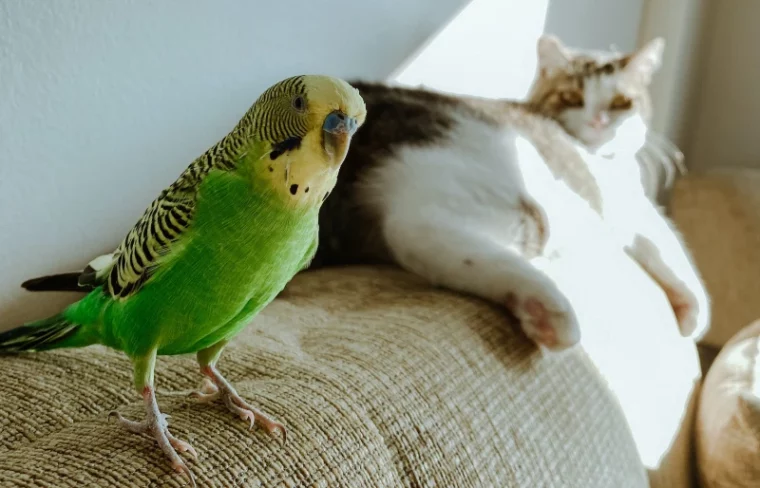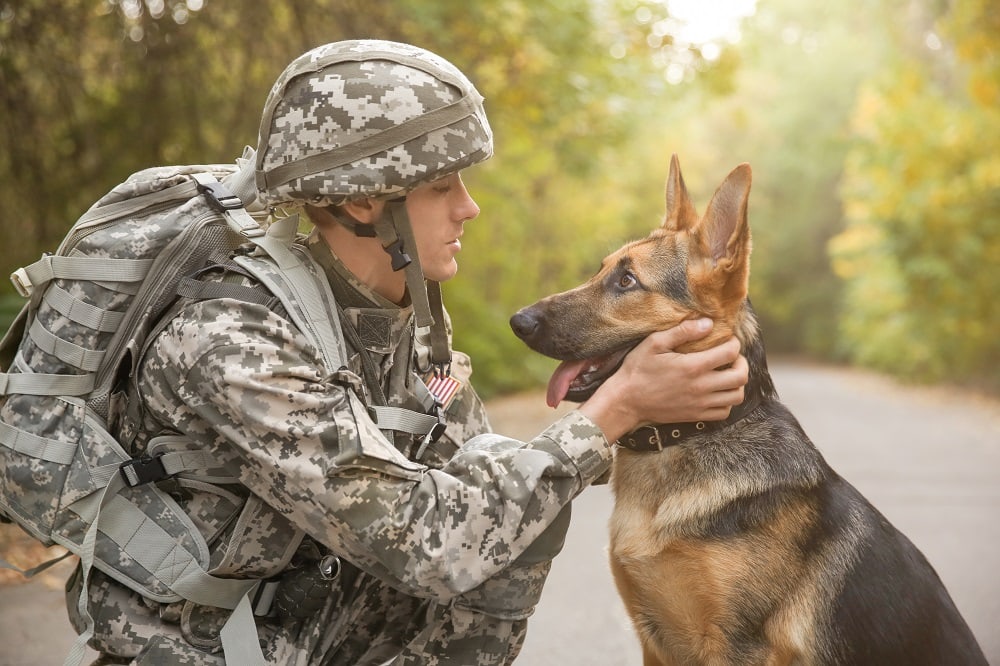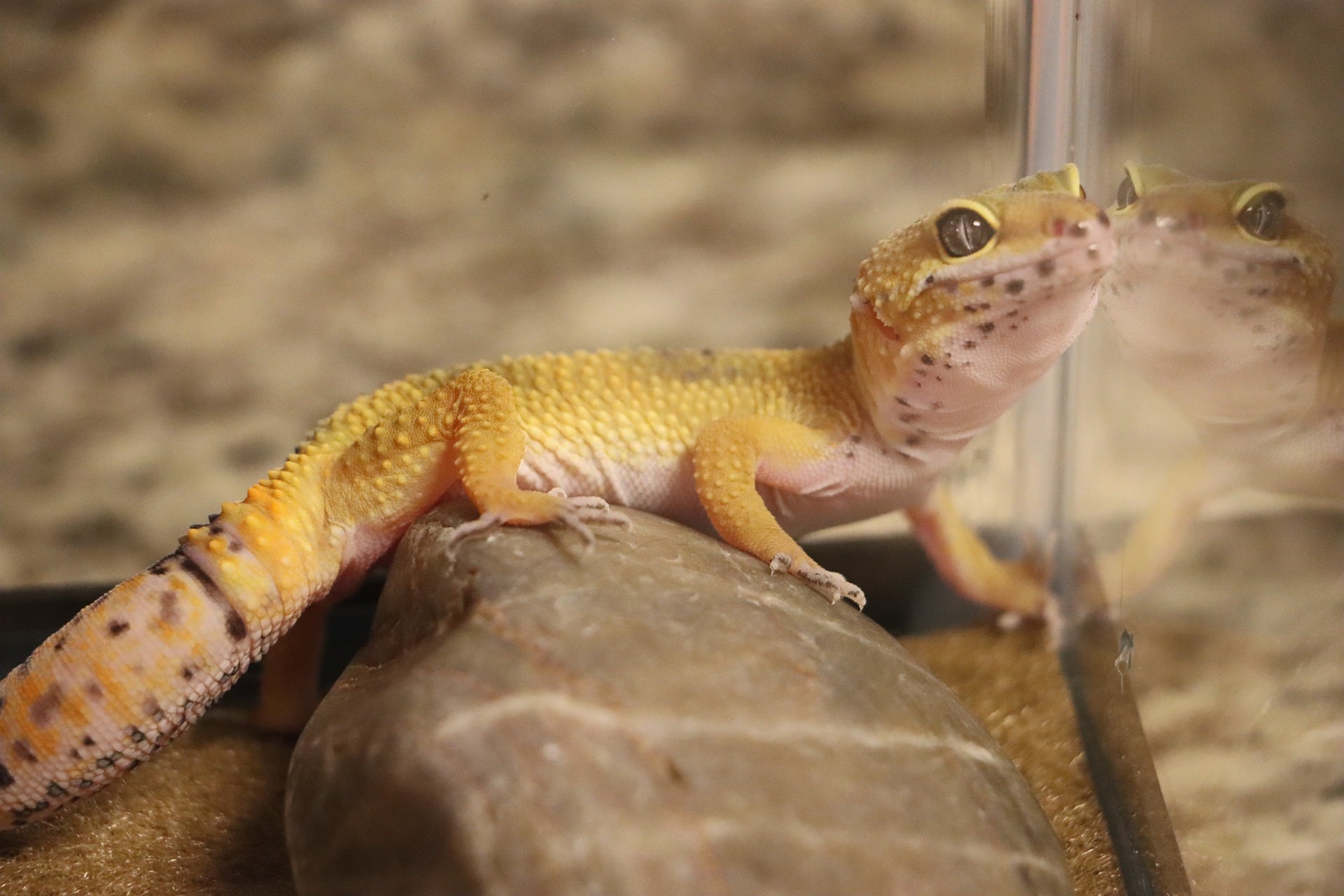
It’s a tale as old as time, the ole cat and mouse—er, bird. Is it possible for a predatory cat to live with a bird? The answer is yes, cats and birds can live together, but only with careful considerations and precautions in place. Even then, we don’t really recommend it. Continue reading to learn more about how to safely share your home with both your feline and avian companions.

Pet Owners Responsibilities
Companion animals exclusively rely on their human counterparts to meet all their nutritional, physical, and mental needs. In 1979, the Five Freedoms were formed by the Farm Animal Welfare Council as a means to highlight the rights an animal under the care of humans should be provided. Although the Five Freedoms were originally designed to help protect farm animals, the freedoms have been extended to all animals under human care.
When considering sharing your home with both a bird and a cat, it is important to ensure that all the Five Freedoms can safely be met for both animals. It is critical to always keep in mind the predator-prey relationship that exists and that it can be set off at any time, even between familiar animals.
Physically having a barrier between animals is the best way to ensure their safety and close supervision is necessary when the animals are allowed close interaction. If the Five Freedoms cannot be safely achieved within the household for both pets, the pet owner can reconsider homing both species.
The 5 Cohabitation Considerations
When trying to facilitate coexistence within a household, there are many factors to take into consideration. It is imperative that the safety and well-being of both animals is always considered. Below are key considerations to investigate when preparing for pet ownership of a bird and cat.
1. Housing
Birds should be kept in enclosures that give them enough room to freely move and explore. It is important that the cage bars are appropriately spaced to prevent the curious feline paw from reaching in and to prevent accidental escape of the bird. The door to the cage should be carefully secured by more than a simple latch as birds and cats are inquisitive and may be able to open the door.
Additionally, the cage should be heavy enough that a startled bird or a cat is unable to tip it over. The location of the cage within the home can vary; however, ideally, birds should be homed in an easily observable space so that unwanted attention from a predator species can be interrupted.

2. Mental and Physical Stimulation
Enclosed animals, including indoor cats, are prone to boredom. Boredom can lead to poor decision-making and health problems. It is important that indoor animals receive plenty of mental and physical stimulation.
Birds without stimulation can self-mutilate and develop unhealthy behaviors. Birds should be provided with engaging toys and exercise time outside of the cage. Alternatively, a bored cat may place more emphasis on a bird within the household, but this attention may be redirected if the cat is involved in frequent playtime and has other outlets to exude energy.
3. Breed Characteristics and Personality Traits
It is important to know the temperament of both the bird and cat prior to introductions. Just like people, every cat and bird is equipped with their own personality. Some birds may be more territorial, whereas others will be more relaxed. The size of the animal needs to be taken into consideration as well. Birds that grow large in size are less likely to be targets of predation.
The temperament of the household cat should also be scrutinized. Even very docile cats can show predatory behavior. Some cats may have aggressive personalities, whereas others may be notoriously laid back. Knowing your cat’s personality will help you gauge if cohabitation is likely to be successful.
In some cases, the age of the animal should be taken into consideration. It might work well to have a kitten introduced to a bird that is already a focal point within the household. This can help to establish a hierarchy but also allows the bird to be seen as an accepted fixture within the household. Once the intrigue is decreased, predatory interest is likely to be less.

4. Body Language Recognition
Being familiar with animal body language and behavior is crucial, especially when predator and prey species are housed together. Predation is a normal cat behavior that is often directed at smaller animals. With the right stimulation, predatory behavior can still occur even in the calmest of cats.
Being able to identify predatory behavior is essential so that redirection and intervention can occur. Similarly, it is necessary to be able to recognize signs of fear or distress, as it is equally as important to be able to recognize signs of relaxation and contentment. Understanding animal behavior will help facilitate a happy coexistence.
5. Training
Cats that will be cohabitating with a bird should be taught acceptable behavior, and desensitization should be attempted. The introduction of animals should be done gradually, as a rush introduction can be detrimental. Although a large majority of cats are not command-trained, it is not impossible! Cats are intelligent species that can be taught commands like “leave it,” “be easy,” and “no.”

In Summary
Although birds and cats are known for having a predator-prey relationship, the two species can technically cohabitate together with certain precautions in place. It is necessary to always ensure that the Five Freedoms are being met for both the bird and the feline companion. Predation is a normal behavior of cats, and it is essential that all interactions between your bird and cat are supervised. With precautions and training in place, cats and birds can sometimes safely coexist within the same home. Still, you need to always keep a watchful eye on this pairing.
Featured Image Credit: Beyzaa Yurtkuran, Pexels








